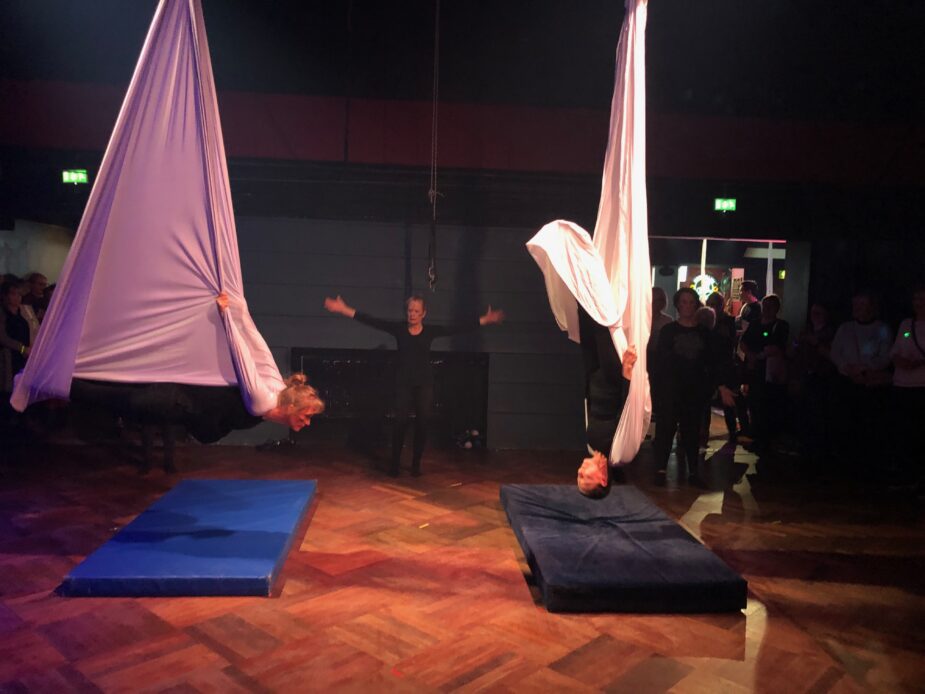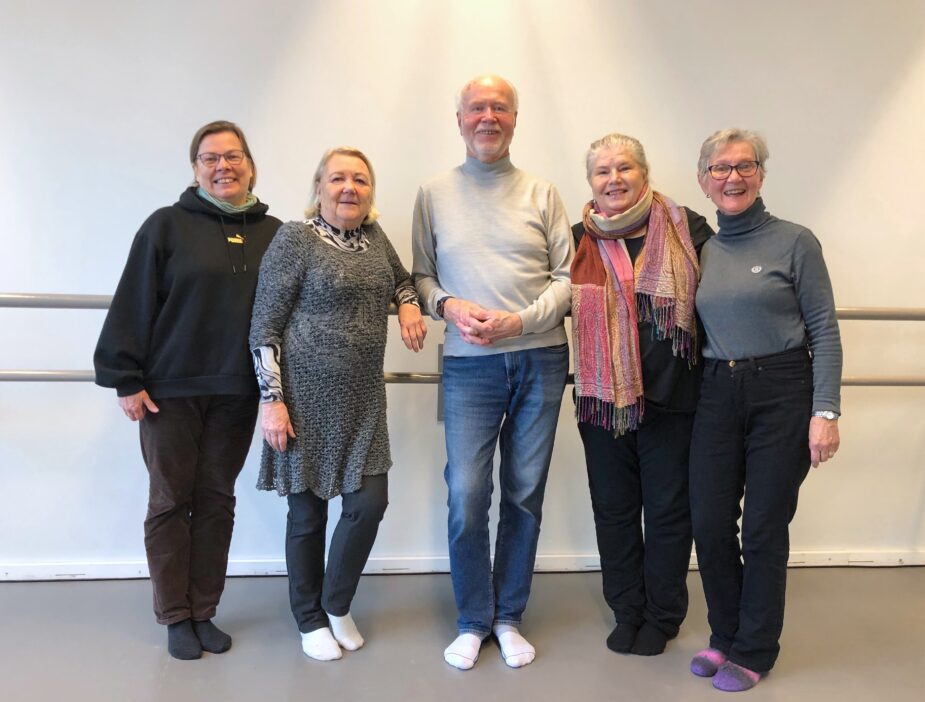Text: Sanna Kangasluoma
When thinking about the cultural hobbies of the elderly, circus or contemporary dance might not be the first things that come to mind. Helsinki-based Circus Magenta and Susanna Leinonen Company have long been engaged in activities that promote movement and culture among elderly individuals. Growing older is not a hindrance or taboo in art forms that often involve learning something new, working in a group, and having the courage to perform in front of an audience.
Women with black lines painted on their faces wrap themselves in silk fabrics, climb inside them, spin in the air, and perform movements. Powerful music plays in the background.
We are witnessing a contemporary circus performance, with the majority of performers being over 65 years old, including some in their seventies. Maija, Maura, Pirjo, Raili, Margit, and Katri make up the performing group known as the Ageless Aerial Acrobats.
“Even though the world’s situation can dampen your spirits, when you go to circus rehearsals, you know that fun is guaranteed,” says Maija Hakkarainen from East Helsinki. “Sometimes we laugh so much that it’s hard to get anything done!” adds Margit Jensen.
Laughter is often triggered by funny moves like the “Moomin in distress,” a name the women came up with for a clumsy-looking maneuver when a person tries to move within a hanging silk fabric.

When trying something entirely new, mistakes are inevitable, and sometimes it looks funny. It’s important to be able to laugh at oneself and be playful, to find the inner child. “Playfulness is wonderful in circus activities – it’s very liberating,” describes Raili Eero.
However, their aerial acrobatics training is goal-oriented, and performing in front of an audience is essential and motivating. “You can show others that aging doesn’t mean sitting in a rocking chair knitting socks. You don’t have to be stuck in one place,” says Maija. “At any age, you can do anything.”
Circus Magenta, whose core activity is social circus, has been home to the Ageless Aerial Acrobats group for about a year now. Most of the performers in this group are retired seniors who had never practiced circus activities before but enthusiastically joined the group when they were suggested.
Overcoming oneself and pushing one’s boundaries is crucial
The cultural and artistic activities of the elderly are often associated with activities like crafts, visual arts, ceramics, woodworking, or theater visits. But there are other options as well.
Comprehensive creative physical activities that engage simultaneously the senses and imagination, which require effort and provide a sense of accomplishment, can significantly support well-being and health, stimulate cognitive skills, and foster social interaction.
“I find it wonderful when there are challenges. To move and perform in the air is entirely different than moving when there is solid ground under your feet – nothing works the way you’re used to. Your body gets completely confused, and that, to me, has been an amazing experience!” says Margit, who joined the group just a couple of months ago.
This is the beginning of a new life
Meanwhile, on the other side of town, Susanna Leinonen Company is currently working on a multidisciplinary piece called Satakieli (“Nightingale”), which will premiere in March 2024. The production includes elderly performers in movement and vocal expression, alongside professional dancers. The participants commit to three months of intensive professional rehearsals. They have a strong desire to learn new things and experience new activities.
Even in old age, one wants new opportunities and can discover new aspects of themselves. Overcoming oneself and pushing one’s boundaries is crucial.
The experience of participation is empowering and activating. Soili Lehtimäki, who has enjoyed singing and reciting poetry throughout her life, says she almost sank into the couch incessantly watching Netflix. Somehow she fortunately managed to pull herself together, applied for the Nightingale production – and was selected!
“For me, this is the beginning of a new life! I enjoy having a tight schedule, demanding almost professional commitment from us – it gets me going,” Soili enthusiastically remarks. “I see the future in a completely different way!”

The purpose of the Nightingale production is to give elderly individuals the experience that their skills are valued, and they are wanted for things, says choreographer Susanna Leinonen who has already created two ambitious contemporary dance works, Juuret (“Roots”) and Arvo (“dignity”, also a forename) in collaboration with elderly individuals and a group of professional dancers.
“Performing is important, it’s about showing others: I can, I am capable, age is not a barrier,” she comments.
Friends add years to life
For the elderly aerial acrobats, the rehearsals where they get to meet nice people, are considered the best day of the week. They have become a close-knit group that does things together even outside of their hobby. They have gone mushroom picking, and exchanged herbs, and some are planning to go on vacation together.
Challenging oneself and putting oneself at risk together as a group bonds people. Increased sense of belonging and participation affects individual self-esteem and the perception of meaningfulness—and it can even extend one’s lifespan. Studies show that isolated and lonely individuals have a 50% higher risk of premature death than those who are socially connected. They also experience more stress, anxiety, depression, and cognitive decline. Isolation increases the risk of dementia by 64%.
Breaking stereotypes about aging
Many have joined circus or performance hobbies because they want meaningful and multifaceted activities, but also to experience and demonstrate that even the elderly have a lot to offer to society.
Retired Henri Soravuo reflects on how our culture is very work-centric. “People who have left the workforce are easily pushed aside; they are treated differently. It’s as if they are no longer acceptable.”
“We become part of the gray mass—someone could almost bump into us on the street because we go unnoticed…,” Soili comments.
Projects like Nightingale are considered to have societal significance, as the number of people over 65 years old is expected to double in the next 40 years – at least in Finland.
“Such a performance challenges societal stereotypes about aging. This production is just one drop in the ocean, but it’s from these drops that the ocean is formed, and, of course, it takes time for things to change,” says Soili.
The other group members agree. It’s essential to have the opportunity to challenge oneself and to feel like an important part of something.
And to become visible.
On the welfare effects of arts and culture
Participating in artistic and cultural activities has been linked to recognized health and well-being benefits. Various research findings and impacts have been summarized in the European “Culture for Health” report. The report describes how cultural activities can provide a comprehensive approach to well-being, shifting the focus from individual diseases to a broader understanding of health. In this way, culture supports health and well-being at the individual level (by promoting physical and mental health and subjective well-being), the community level (by fostering social inclusion and commitment to communities and their resilience), and the economic level (using the concept of well-being economy described by the OECD, it enhances vitality and helps contain costs, including those in social and healthcare).
